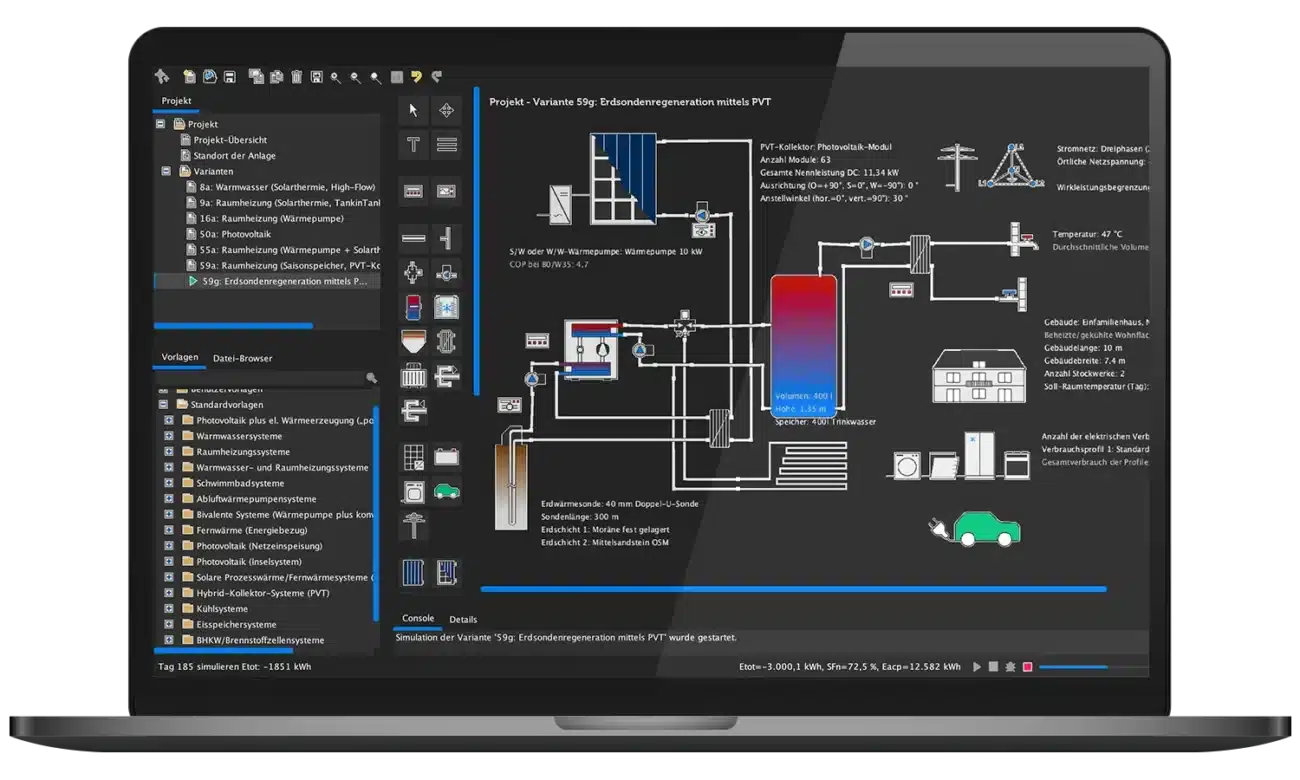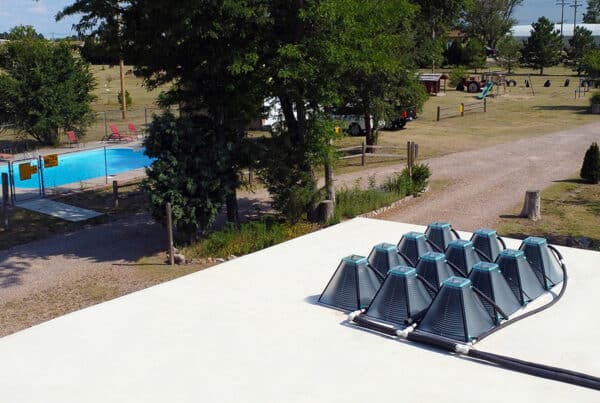In the growing field of renewable energy and sustainable engineering, solar hot water systems offer significant potential for energy savings and carbon reduction. But for engineers and sustainability consultants, quantifying precisely how much energy will be saved is critical for informed decision-making. Transient energy modelling using specialised software such as Polysun provides a comprehensive tool to accurately predict these savings, allowing for optimised system design and performance analysis. In this article, we’ll explore how Polysun is used to evaluate solar hot water system performance, detailing the critical variables impacting energy savings, including daily hot water consumption, local climate conditions, and the design and size of the solar system.
Understanding Transient Energy Modelling with Polysun
Transient energy modelling involves simulating how solar hot water systems perform under varying conditions over time, typically hourly or even minute-by-minute. Polysun, a leading software package, provides detailed and realistic performance simulations by factoring in dynamic inputs, including weather patterns, consumption profiles, system configurations, and thermal storage capacities. Unlike static calculations, transient modelling captures real-world variability, delivering more accurate energy savings estimates.

Solar hot water Energy modelling with Polysun (courtesy: Vela Solaris, Switzerland)
Key Variables Impacting Energy Savings
1. Daily Hot Water Consumption
Daily hot water consumption significantly influences the effectiveness and savings potential of solar hot water systems. Polysun allows engineers to define precise consumption patterns, including variations throughout the day and across different user profiles such as residential, hospitality, or industrial applications. Accurate modelling of hot water consumption ensures the system design closely matches actual usage, maximizing efficiency.
For instance, a hotel with peak morning and evening usage periods will have a different demand profile than a residential building with relatively consistent, lower-volume consumption. Polysun’s capability to model such nuanced profiles helps avoid oversizing or undersizing systems, directly impacting both energy savings and return on investment.
2. Local Climate Conditions
The local climate profoundly affects solar thermal system performance. Polysun includes detailed climate databases for locations worldwide, incorporating historical weather data, solar radiation levels, ambient temperature fluctuations, and seasonal variations. Precise climate modelling allows sustainability engineers to predict system behaviour under realistic conditions.
For example, installations in sunny climates such as the UAE or Kenya will naturally yield higher solar fractions—reducing energy demand on conventional heating methods—compared to colder or cloudier locations. Polysun can simulate system performance across multiple climate scenarios, empowering engineers to optimize designs specifically tailored to their geographic conditions.
3. System Size and Design
The configuration of a solar hot water system—including collector area, type (flat plate, evacuated tube, polymer collector like SolarisKit’s innovative solution), orientation, tilt, and storage capacity—is another critical determinant of energy savings. Polysun enables detailed optimization by allowing users to experiment with multiple system configurations, instantly evaluating performance trade-offs and identifying the most cost-effective solutions.
For instance, a larger collector area might significantly boost energy collection but at increased capital costs and potential overheating issues. Conversely, undersized systems may fail to deliver adequate savings or meet hot water demand fully. Transient modelling through Polysun facilitates iterative design refinements to strike the ideal balance between energy efficiency, cost, and system longevity.
Polysun in Practice: A Case Study
Let’s consider a practical example using Polysun to demonstrate the modelling process. Imagine designing a solar hot water system for a mid-sized residential building in Dubai. The project aims to replace conventional electric water heating, significantly reducing carbon emissions and operating costs.
Using Polysun, the engineer first inputs detailed data on daily hot water usage—say, an average of 400 litres per day, with peaks in the morning and evening. Next, Polysun integrates Dubai’s specific climate data, capturing high solar irradiance, seasonal temperature variations, and reduced solar availability during dust storm events.
The engineer experiments with multiple collector scenarios, comparing a system using the SolarisKit polymer solar collector against traditional flat plate collectors. The transient modelling reveals that the SolarisKit collector offers higher resilience to overheating and superior performance under Dubai’s intense summer conditions.
Polysun then calculates annual and monthly energy savings, clearly demonstrating how much electricity and associated carbon emissions the building can save annually. Through iterative modelling, the optimal system size and storage tank volume are identified, maximising economic viability and environmental impact.
Practical Insights for Engineers
For MEP and sustainability professionals, transient energy modelling using Polysun offers actionable insights:
- Accurate Predictions: Dynamic modelling leads to more precise energy savings estimates compared to traditional static calculations.
- Optimised Designs: Enables iterative refinement of system parameters to achieve the ideal balance between performance, cost, and reliability.
- Tailored Solutions: Facilitates design solutions tailored specifically to local climate conditions and user demand profiles.
- Enhanced Decision-Making: Provides clear, quantifiable data to inform client decisions, investments, and sustainability reporting.
Conclusion
Determining exactly how much energy you’ll save by installing a solar hot water system involves understanding complex interactions between hot water demand, climate, and system configuration. Transient energy modelling with Polysun software is indispensable for professional engineers and sustainability consultants, delivering precise predictions and optimized solutions tailored to specific project requirements.
By leveraging the power of Polysun, MEP, architects, and building professionals can confidently answer the crucial question: “How much energy will I save installing a solar hot water system?” and make data-driven decisions that effectively advance sustainability objectives.
If you require transient energy modelling for your next solar hot water project, please contact us today. Our highly experienced team of engineers will be happy to assist you.




